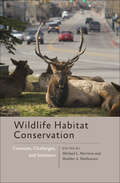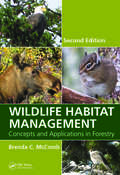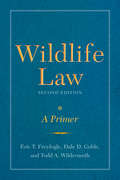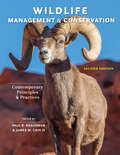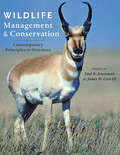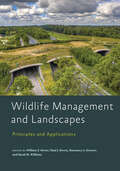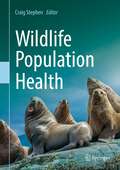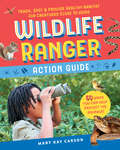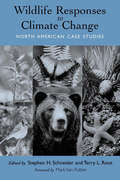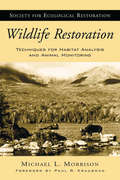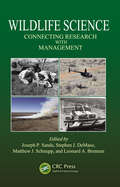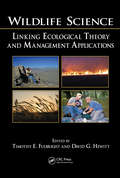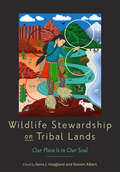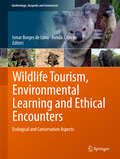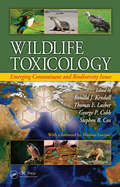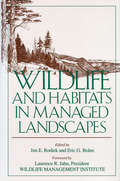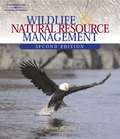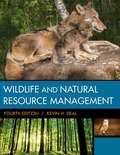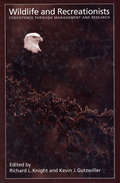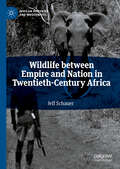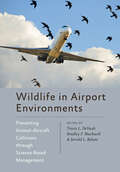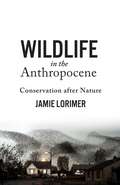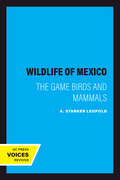- Table View
- List View
Wildlife Habitat Conservation: Concepts, Challenges, and Solutions (Wildlife Management and Conservation)
by Heather A. Mathewson and Michael L. MorrisonA book that emphasized the concept of wildlife habitat for a generation of students and professionals is now available to even more readers."Habitat" is probably the most common term in ecological research. Elementary school students are introduced to the term, college students study the concept in depth, hunters make their plans based on it, nature explorers chat about the different types, and land managers spend enormous time and money modifying and restoring habitats. Although a broad swath of people now have some notion of what habitat is, the scientific community has by and large failed to define it concretely, despite repeated attempts in the literature to come to meaningful conclusions regarding what habitat is and how we should study, manipulate, and ultimately conserve it.Wildlife Habitat Conservation presents an authoritative review of the habitat concept, provides a scientifically rigorous definition, and emphasizes how we must focus on those critical factors contained within what we call habitat. The result is a habitat concept that promises long-term persistence of animal populations. Key concepts and items in the book include:• Rigorous and standard conceptual definitions of wildlife and their habitat.• A discussion of the essential integration of population demographics and population persistence with the concept of habitat.• The importance of carryover and lag effects, behavioral processes, genetics, and species interactions to our understanding of habitat. • An examination of spatiotemporal heterogeneity, realized through fragmentation, disruption to eco-evolutionary processes, and alterations to plant and animal assemblages.• An explanation of how anthropogenic effects alter population size and distribution (isolation), genetic processes, and species diversity (including exotic plants and animals).• Advocacy of proactive management and conservation through predictive modeling, restoration, and monitoring.Each chapter is accessibly written in a style that will be welcomed by private landowners and public resource managers at local, state, and federal levels. Also ideal for undergraduate and graduate natural resource and conservation courses, the book is organized perfectly for a one-semester class.Published in association with The Wildlife Society.
Wildlife Habitat Management: Concepts and Applications in Forestry, Second Edition
by Brenda C. McCombShortlisted for the 2018 TWS Wildlife Publication Awards in the authored book categoryIn recent years, conflicts between ecological conservation and economic growth forced a reassessment of the motivations and goals of wildlife and forestry management. Focus shifted from game and commodity management to biodiversity conservation and ecological fore
Wildlife Law, Second Edition: A Primer
by Eric T. Freyfogle Dale D. Goble Dr Todd A. WildermuthWildlife is an important and cherished element of our natural heritage in the United States. But state and federal laws governing the ways we interact with wildlife can be complex to interpret and apply. Ten years ago, Wildlife Law: A Primer was the first book to lucidly explain wildlife law for readers with little or no legal training who needed to understand its intricacies. Today, navigating this legal terrain is trickier than ever as habitat for wildlife shrinks, technology gives us new ways to seek out wildlife, and unwanted human-wildlife interactions occur more frequently, sometimes with alarming and tragic outcomes.This revised and expanded second edition retains key sections from the first edition, describing basic legal concepts while offering important updates that address recent legal topics. New chapters cover timely issues such as private wildlife reserves and game ranches, and the increased prominence of nuisance species as well as an expanded discussion of the Endangered Species Act, now more than 40 years old. Chapter sidebars showcase pertinent legal cases illustrating real-world application of the legal concepts covered in the main text.Accessibly written, this is an essential, groundbreaking reference for professors and students in natural resource and wildlife programs, land owners, and wildlife professionals.
Wildlife Management and Conservation: Contemporary Principles and Practices
by Paul R. Krausman And James W. Cain IIIThe definitive textbook for students of wildlife management, now updated to cover the latest techniques, tools, and topics.Wildlife Management and Conservation presents a clear overview of the management and conservation of animals, their habitats, and how people influence both. The relationship among these three components of wildlife management is explained in chapters written by leading experts and is designed to prepare students for careers in which they will be charged with maintaining healthy animal populations. To be successful wildlife professionals, they will need to find ways to restore depleted populations, reduce overabundant, introduced, or pest species, and manage relationships among various human stakeholders. This book gives them the basic knowledge necessary to accomplish these goals.This second edition, which is updated throughout, features several new and expanded topics, including communication in the wildlife profession, fire science, Indigenous models of management and conservation, plant–animal interactions, quantitative analysis of wildlife populations, and a detailed glossary. The book also covers:• Human dimensions of wildlife management• Animal behavior• Predator–prey relationships• Structured decision making• Issues of scale in wildlife management• Wildlife health• Historical context of wildlife management and conservation• Hunting and trapping• Nongame species• Nutrition ecology• Water management• Climate change• Conservation planningThe most widely used foundational text in the field, this is the perfect resource not only for students but also for early career professionals and those in related fields who need to understand the core tenets and tools of wildlife conservation and management.Contributors: C. Jane Anderson, Bart M. Ballard, Warren B. Ballard, John A. Bissonette, Clint Boal, Scott B. Boyle, Leonard A. Brennan, Robert D. Brown, James W. Cain III, Tyler A. Campbell, Michael J. Cherry, Michael R. Conover, Daniel J. Decker, Randall W. DeYoung, Jonathan B. Dinkins, W. Sue Fairbanks, Selma N. Glasscock, James B. Grand, Michael J. Haney, James R. Heffelfinger, Scott E. Henke, Fidel Hernandez, Davie G. Hewitt, C. L. Hoving, David A. Jessup, Heather E. Johnson, Winifred B. Kessler, John L. Koprowski, Paul R. Krausman, William P. Kuvlesky, Jr., Roel R. Lopez, R. W. Mannan, Scott Mills, Michael S. Mitchell, Michael L. Morrison, Anna M. Muñoz, John F. Organ, Katherine L. Parker, William F. Porter, Shawn J. Riley, Steven S. Rosenstock, Michael C. Runge, Susan P. Rupp, William F. Siemer, Robert J. Steidl, Kelley M. Stewart
Wildlife Management and Conservation: Contemporary Principles and Practices (Wildlife Management And Conservation Ser.)
by Paul R. Krausman James W. Cain IIIA definitive textbook for students of wildlife management.Wildlife Management and Conservation presents a clear overview of the management and conservation of animals, their habitats, and how people influence both. The relationship among these three components of wildlife management is explained in chapters written by leading experts and is designed to prepare wildlife students for careers in which they will be charged with maintaining healthy animal populations; finding ways to restore depleted populations while reducing overabundant, introduced, or pest species; and managing relationships among various human stakeholders.Topics covered in this book include• The definitions of wildlife and management• Human dimensions of wildlife management• Animal behavior• Predator–prey relationships • Structured decision making• Issues of scale in wildlife management• Wildlife health• Historical context of wildlife management and conservation• Hunting and trapping• Nongame species• Nutrition ecology• Water management• Climate change• Conservation planning
Wildlife Management and Landscapes: Principles and Applications (Wildlife Management and Conservation)
by William F. Porter, Chad J. Parent, Rosemary A. Stewart and David M. WilliamsWildlife management specialists and landscape ecologists offer a new perspective on the important intersection of these fields in the twenty-first century.It's been clear for decades that landscape-level patterns and processes, along with the tenets and tools of landscape ecology, are vitally important in understanding wildlife-habitat relationships and sustaining wildlife populations. Today, significant shifts in the spatial scale of extractive, agricultural, ranching, and urban land uses are upon us, making it more important than ever before to connect wildlife management and landscape ecology. Landscape ecologists must understand the constraints that wildlife managers face and be able to use that knowledge to translate their work into more practical applications. Wildlife managers, for their part, can benefit greatly from becoming comfortable with the vocabulary, conceptual processes, and perspectives of landscape ecologists.In Wildlife and Landscapes, the foremost landscape ecology experts and wildlife management specialists come together to discuss the emerging role of landscape concepts in habitat management. Their contributions• make the case that a landscape perspective is necessary to address management questions• translate concepts in landscape ecology to wildlife management• explain why studying some important habitat-wildlife relationships is still inherently difficult• explore the dynamic and heterogeneous structure of natural systems• reveal why factors such as soil, hydrology, fire, grazing, and timber harvest lead to uncertainty in management decisions• explain matching scale between population processes and management• discuss limitations to management across jurisdictional boundaries and balancing objectives of private landowners and management agencies• offer practical ideas for improving communication between professionals• outline the impediments that limit a full union of landscape ecology and wildlife managementUsing concrete examples of modern conservation challenges that range from oil and gas development to agriculture and urbanization, the volume posits that shifts in conservation funding from a hunter constituent base to other sources will bring a dramatic change in the way we manage wildlife. Explicating the foundational similarity of wildlife management and landscape ecology, Wildlife and Landscapes builds crucial bridges between theoretical and practical applications.Contributors: Jocelyn L. Aycrigg, Guillaume Bastille-Rousseau, Jon P. Beckmann, Joseph R. Bennett, William M. Block, Todd R. Bogenschutz, Teresa C. Cohn, John W. Connelly, Courtney J. Conway, Bridgett E. Costanzo, David D. Diamond, Karl A. Didier, Lee F. Elliott, Michael E. Estey, Lenore Fahrig, Cameron J. Fiss, Jacqueline L. Frair, Elsa M. Haubold, Fidel Hernández, Jodi A. Hilty, Joseph D. Holbrook, Cynthia A. Jacobson, Kevin M. Johnson, Jeffrey K. Keller, Jeffery L. Larkin, Kimberly A. Lisgo, Casey A. Lott, Amanda E. Martin, James A. Martin, Darin J. McNeil, Michael L. Morrison, Betsy E. Neely, Neal D. Niemuth, Chad J. Parent, Humberto L. Perotto-Baldivieso, Ronald D. Pritchert, Fiona K. A. Schmiegelow, Amanda L. Sesser, Gregory J. Soulliere, Leona K. Svancara, Stephen C. Torbit, Joseph A. Veech, Kerri T. Vierling, Greg Wathen, David M. Williams, Mark J. Witecha, John M. Yeiser
Wildlife Politics
by Bruce RocheleauAttitudes towards charismatic animals such as tigers, lions, bears and wolves vary greatly and change over time, resulting in bitter political debates. This comprehensive book identifies and analyses the factors that influence policies across the globe, highlighting how this impacts conservation as a whole. Issues such as overexploitation, hunting, ecotourism and the struggle to prevent illegal wildlife trafficking are examined and science's role in policymaking is assessed. The conflicting forces behind legislation, including institutions, interest groups and the media are analysed, with particular focus on the significance of the Endangered Species Act, covering over forty-five species that have become matters of political debate in sixty-seven different countries. Case studies and conceptual frameworks provide a clear understanding of the key topics, shedding light on this important yet often overlooked area of environmental politics.
Wildlife Population Health
by Craig StephenThis textbook introduces the core competencies, tools and perspectives to manage free-ranging animal population health and demonstrates their need and relevance to help wildlife cope with the ever-increasing pressures of the Anthropocene, manifested by global megatrends such as climate change, urbanization and pollution. It adapts and adopts key concepts of population health from public health and herd health to a wildlife health context. In a highly-accessible and unique form, this book presents a modern way of approaching wildlife and fish epidemiology, health promotion and disease control, with a focus on the social dimensions of wildlife health management. Aimed at graduate students in veterinary medicine, wildlife researchers and health managers this textbook provides a valuable source of information to foster the knowledge and skills needed to protect and promote the health of free-ranging wildlife.
Wildlife Ranger Action Guide: Track, Spot & Provide Healthy Habitat for Creatures Close to Home
by Mary Kay CarsonAs concern for the welfare of species like honey bees and monarch butterflies grows alongside awareness of the impact of climate change, inspiring the next generation of citizen scientists is more important than ever. With Wildlife Ranger Action Guide, kids can make the world better for the animals and insects they love, starting right in their own backyards. Dozens of hands-on activities and habitat creation projects, such as making a frog pond from a kiddie pool, planting a pollinator garden for bees, painting a bat house, and building a lodge for lizards, encourage children to learn about and take an active role in protecting local wildlife. Lively photographic field guides covering 78 North American wildlife species teach kids about the habits and habitats of each and include tips for providing the plants and food needed for their survival. This publication conforms to the EPUB Accessibility specification at WCAG 2.0 Level AA.
Wildlife Rescue: The Work of Dr. Kathleen Ramsay
by Jennifer Owings Dewey Don Maccarter Jenn DeweyThe story of Dr. Kathleen Ramsay's wildlife center in New Mexico. How the Wildlife Center, based in Española, New Mexico, and headed by Dr. Kathleen Ramsay, nurtures sick and injured animals back to health.
Wildlife Responses to Climate Change: North American Case Studies
by Stephen H. Schneider Terry Root Mark Van PuttenWildlife Responses to Climate Change is an important addition to the body of knowledge critical to scientists, resource managers, and policymakers in understanding and shaping solutions to problems caused by climate change. It provides a useful resource for students and scientists studying the effects of climate change on wildlife and will assist resource managers and other wildlife professionals to better understand factors affecting the species they are striving to conserve.
Wildlife Restoration: Techniques for Habitat Analysis and Animal Monitoring (Science Practice Ecological Restoration #1)
by Michael L. Morrison Paul R. KrausmanWildlife Restoration links restoration ecology and wildlife management in an accessible and comprehensive guide to restoring wildlife and the habitats upon which they depend. It offers readers a thorough overview of the types of information needed in planning a wildlife-habitat restoration project and provides the basic tools necessary for developing and implementing a rigorous monitoring program. The book: explains the concepts of habitat and niche: their historic development, components, spatial-temporal relationships, and role in land management reviews how wildlife populations are identified and counted considers captive breeding, reintroduction, and translocation of animals discusses how wildlife and their habitat needs can be incorporated into restoration planning develops a solid justification for monitoring and good sampling design in restoration projects discusses and critiques case histories of wildlife analysis in restoration projectsThe author does not offer a "cookbook" approach, but rather provides basic tools for understanding ecological concepts that can be used to design restoration projects with specific goals for wildlife. He focuses on developing an integrated approach to large-scale landscape restoration. In addition, he provides guidance on where more advanced and detailed literature can be found.Wildlife Restoration sets forth a clear explanation of key principles of wildlife biology for the restorationist, and will allow wildlife biologists to bring the insights of their field to restoration projects. It is an essential source of information for everyone involved with studying, implementing, or managing wildlife restoration projects, including students, ecologists, administrators, government agency staff, and volunteer practitioners.
Wildlife Science: Connecting Research with Management
by Leonard A. Brennan Joseph P. Sands Stephen J. DeMaso Matthew J. SchnuppDespite the potential synergy that can result from basing management applications on results from research, there is a polarization of cultures between wildlife managers and wildlife researchers. Wildlife Science: Connecting Research with Management provides strategies for bridging cultural and communication gaps between these groups. The text covers the history of the longstanding disconnect, research and management entities, species case studies, management and policy case studies, and conclusions and future directions. The authors present case studies of both successful and failed interactions, providing a platform for discussion of the underlying issues. They examine current issues in wildlife science and management to explore real-world implications resulting from the research and management disconnect.
Wildlife Science: Linking Ecological Theory and Management Applications
by Timothy E. Fulbright and David G. HewittConsciously or not, wildlife managers generally act from a theoretical basis, although they may not be fully versed in the details or ramifications of that theory. In practice, the predictions of the practitioners sometimes prove more accurate than those of the theoreticians. Practitioners and theoreticians need to work together, but this proves di
Wildlife Stewardship on Tribal Lands: Our Place Is in Our Soul
by Serra J. Hoagland and Steven AlbertThis groundbreaking book brings together Native American and Indigenous scholars, wildlife managers, legal experts, and conservationists from dozens of tribes to share their wildlife stewardship philosophies, histories, principles, and practices.Tribes have jurisdiction over some of the healthiest wild areas in North America, collectively managing over 56 million acres of land. This is no accident: in addition to a deep reverence for the land and a strong history of environmental stewardship, Native peoples implement some of the best fish and wildlife preservation and management practices on the continent. Wildlife Stewardship on Tribal Lands is the first comprehensive resource dedicated to the voices and expertise of Native scholars and wildlife professionals. In its pages, nearly one hundred Native and non-native wildlife conservationists, managers, and their collaborators share lessons to guide wildlife professionals in how best to incorporate native methods and how to work effectively with tribal stakeholders. The authors cover topics that include:• Guidelines for conducting research on tribal lands• Traditional ecological knowledge-based management models• The cultural and ecological importance of key species• Legal battles for treaty rights, management authority, and funding• First foods and food sovereignty • Fisheries and migratory bird management• Tribal perspectives on the Endangered Species Act• A history of modern fish and wildlife management on tribal landsThe content of this book is not limited to the invaluable reports of research findings, explications of methodologies, and case studies. Capturing oral histories and spiritual knowledge through interviews with tribal leaders and the work of Native artists and writers honors the holistic awareness of the land offered to readers of this unique volume. Ultimately, the contributors to Wildlife Stewardship on Tribal Lands demonstrate how tribal practices are pivotal guideposts for those seeking to protect and harness our natural resources in ways that can help reverse grievous biodiversity losses and ensure the health of our environment for future generations.Contributors: Scott Aikin, Steven Albert, John Antonio, Dale Becker, Bethany Berger, Kimberly Blaeser, Arthur Blazer, Michael Blumm, Michael Brydge, Ashley Carlisle, Frank Cerno Jr., Sally Carufel Williams, Guy Charlton, Samuel Chischilly, Bob Christensen, Gerald Cobell, Cody Desautel, Lauren Divine, Douglas W. Dompier, Ramona Emerson, Kari Eneas, James Fall, Julian J. Fischer, James R. Floyd, James Gensaw Sr., Michael I. Goldstein, Kim Gottschalk, Shaun Grassel, E. Richard Hart, Dylan R. Hedden-Nicely, Caleb Hickman, Serra J. Hoagland, Kraig Holmes, Nathan Jim, R. Roy Johnson, Jovon Jojola, Tamra Jones, Emily Sylvan Kim, Winona LaDuke, Stacy Leeds, Crystal Leonetti, Aaron P. Lestenkof, Chip Livingston, Lorraine Marquez Eiler, Eric Mellink, Paul I. Melovidov, Lara Mengak, Gary Paul Nabhan, Liliana Naves, Vern Northrup, nila northSun, Raymond E. Paddock III, Lizzy Pennock, Nicole Marie Pete, Aaron Poe, Georgiana Pongyesva, Ken Poynter, Mathis Quintana, Seafha Ramos, Janisse Ray, Vanessa L. Ray-Hodge, Amadeo Rea, Mitzi Reed, Marcie Rendon, Sarah F. Rinkevich, Bruce Robson, Andrea Rogers, Thomas C. Rothe, David E. Safine, Patty Schwalenberg, Kyle Secakuku, John Sewall, Todd Sformo, Richard T. Sherman, Ron Skates, Arthur M. Soukkala, Lawrence Stevens, Juliana Suzukawa, Julie Thorstenson, Gloria Tom, Christopher Tran, Craig van der Heiden, John Wheeler, Jessica Wiarda, Tiana Williams-Claussen.
Wildlife Tourism, Environmental Learning and Ethical Encounters
by Ronda J. Green Ismar Borges de LimaThis book outlines the status quo of worldwide wildlife tourism and its impacts on planning, management, knowledge, awareness, behaviour and attitudes related to wildlife encounters. It sets out to fill the considerable gaps in our knowledge on wildlife tourism, applied ecology, and environmental education, providing comprehensive information on and an interdisciplinary approach to effective management in wildlife tourism. Examining the intricacies, challenges, and lessons learned in a meaningful and rewarding tourism niche, this interdisciplinary book comprehensively examines the major potentials and controversies in the wildlife tourism industry. Pursuing an insightful, provocative and hands-on approach, it primarily addresses two questions: ‘Can we reconcile the needs of the wildlife tourism industry, biodiversity conservation, ecological learning and animal ethics issues?’ and ‘What is the Future of the Wildlife Tourism Industry?’. Though primarily intended as a research text, it also offers a valuable resource for a broad readership, which includes university and training students, researchers, scholars, tourism practitioners and professionals, planners and managers, as well as the staff of government agencies.
Wildlife Toxicology: Emerging Contaminant and Biodiversity Issues
by Ronald J. Kendall Stephen B. CoxUpdating the extremely successful Wildlife Toxicology and Population Modeling (CRC Press, 1994), Wildlife Toxicology: Emerging Contaminant and Biodiversity Issues brings together a distinguished group of international contributors, who provide a global assessment of a range of environmental stressors, including pesticides, environmental contaminant
Wildlife and Habitats in Managed Landscapes
by Eric Bolen Jon RodiekAmericans are having an increasing impact on the rural landscape as development further encroaches in former wilderness areas. This disruptive land use is causing a decline in wildlife and wildlife habitats. Wildlife and Habitats in Managed Landscapes presents a new strategy for solving this problem by redefining habitats to include the concept of landscape. Employing this strategy, natural resource managers apply tools of planning, management, and design to entire landscapes to meet the needs of both wildlife and humans.
Wildlife and Natural Resource Management
by Kevin H. DealFor agricultural extension professionals, nature conservatory staff and others, this book offers complete coverage of a very complex subject. Wildlife and Natural Resource Management provides detailed, in-depth looks at many subjects such as: the history of wildlife conservation in America, the history of modern wildlife and fisheries management, the various federal and state agencies responsible for wildlife and fisheries management, the financing of wildlife conservation in America, and the numerous private conservation organizations are all discussed in detail. Wildlife and Natural Resource Management also provides a look at fossil fuels, their role in our society and their conservation, as well as discussing soil, forest, and water management and conservation. The habitat requirements, feeding and breeding habits of most species of native fauna are discussed. Descriptions and ranges are covered with photos where possible. Endangered species and the Endangered Species Act and its effect of endangered species are also covered. The glossary and appendices are complete to be useful to the student. While a tremendous amount of information is presented between the covers, it is written in such a way as to be easy to read and hold the reader's attention.
Wildlife and Recreationists: Coexistence Through Management And Research
by Joanna Burger Daniel J. Decker Richard L. Knight Kevin Gutzwiller H. Ken Cordell Paul KerlingerWildlife and Recreationists defines and clarifies the issues surrounding the conflict between outdoor recreation and the health and well-being of wildlife and ecosystems. Contributors to the volume consider both direct and indirect effects of widlife-recreationist interactions, including: *wildlife responses to disturbance, and the origins of these responses *how specific recreational activities affect diverse types of wildlife *the human dimensions of managing recreationists *the economic importance of outdoor recreation *how wildlife and recreationists might be able to coexist The book is a useful synthesis of what is known concerning wildlife and recreation. More important, it addresses both research needs and management options to minimize conflicts.
Wildlife between Empire and Nation in Twentieth-Century Africa (African Histories and Modernities)
by Jeff SchauerThis book traces the emergence of wildlife policy in colonial eastern and central Africa over the course of a century. Spanning from imperial conquest through the consolidation of colonial rule, the rise of nationalism, and the emergence of neocolonial and neoliberal institutions, this book shows how these fundamental themes of the twentieth century shaped the relationships between humans and animals in what are today Kenya, Tanzania, Uganda, Zambia, and Malawi. A set of key themes emerges—changing administrative forms, militarization, nationalism, science, and a relentlessly broadening constituency for wildlife. Jeff Schauer illuminates how each of these developments were contingent upon the colonial experience, and how they fashioned a web of structures for understanding and governing wildlife in Africa—one which has lasted into the twenty-first century.
Wildlife in Airport Environments: Preventing Animal–Aircraft Collisions through Science-Based Management (Wildlife Management and Conservation)
by Travis L. DeVault Bradley F. Blackwell Jerrold L. BelantA comprehensive overview of wildlife issues facing airports and how to minimize conflicts.Winner of the NWRC Publication Award of the National Wildlife Research CenterThe pilot watches the instrument panel and prepares for touchdown—a routine landing until a burst of birds, a coyote, or a herd of deer crosses the runway! Every year, pilots experience this tension and many aircraft come into direct contact with birds and other wildlife, resulting in more than one billion dollars in damage annually. The United States Federal Aviation Administration has recorded a rise in these incidents over the past decade due to the combined effects of more reporting, rebounding wildlife populations, and an increased number of flights. Wildlife in Airport Environments tackles the issue of what to do about encounters with wildlife in and around airports—from rural, small-craft airparks to major international hubs. Whether the problem is birds or bats in the flight path or a moose on the runway, the authors provide a thorough overview of the science behind wildlife management at airports. This well-written, carefully documented volume presents a clear synthesis for researchers, wildlife managers, and airport professionals. The book belongs in the hands of all those charged with minimizing the risks that wildlife pose to air travel.Wildlife in Airport Environments is the first book in the series Wildlife Management and Conservation and is published in association with The Wildlife Society.ContributorsMichael L. Avery, U.S. Department of AgricultureJerrold L. Belant, Mississippi State UniversityKristin M. Biondi, Mississippi State UniversityBradley F. Blackwell, U.S. Department of AgricultureJonathon D. Cepek, U.S. Department of AgricultureLarry Clark, U.S. Department of AgricultureTara J. Conkling, Mississippi State UniversityScott R. Craven, University of Wisconsin–MadisonPaul D. Curtis, Cornell UniversityTravis L. DeVault, U.S. Department of AgricultureRichard A. Dolbeer, U.S. Department of AgricultureDavid Felstul, U.S. Department of the InteriorEsteban Fernández-Juricic, Purdue UniversityAlan B. Franklin, U.S. Department of AgricultureSidney A. Gauthreaux Jr., Clemson UniversityMichael Lavelle, U.S. Department of AgricultureJames A. Martin, Mississippi State UniversityRebecca Mihalco, U.S. Department of AgriculturePaige M. Schmidt, U.S. Fish and Wildlife ServiceThomas W. Seamans, U.S. Department of AgricultureKurt C. VerCauteren, U.S. Department of AgricultureBrian E. Washburn, U.S. Department of Agriculture
Wildlife in the Anthropocene: Conservation after Nature
by Jamie LorimerElephants rarely breed in captivity and are not considered domesticated, yet they interact with people regularly and adapt to various environments. Too social and sagacious to be objects, too strange to be human, too captive to truly be wild, but too wild to be domesticated—where do elephants fall in our understanding of nature? In Wildlife in the Anthropocene, Jamie Lorimer argues that the idea of nature as a pure and timeless place characterized by the absence of humans has come to an end. But life goes on. Wildlife inhabits everywhere and is on the move; Lorimer proposes the concept of wildlife as a replacement for nature. Offering a thorough appraisal of the Anthropocene—an era in which human actions affect and influence all life and all systems on our planet— Lorimer unpacks its implications for changing definitions of nature and the politics of wildlife conservation. Wildlife in the Anthropocene examines rewilding, the impacts of wildlife films, human relationships with charismatic species, and urban wildlife. Analyzing scientific papers, policy documents, and popular media, as well as a decade of fieldwork, Lorimer explores the new interconnections between science, politics, and neoliberal capitalism that the Anthropocene demands of wildlife conservation. Imagining conservation in a world where humans are geological actors entangled within and responsible for powerful, unstable, and unpredictable planetary forces, this work nurtures a future environmentalism that is more hopeful and democratic.
Wildlife of Mexico: The Game Birds and Mammals
by A. Starker LeopoldThis title is part of UC Press's Voices Revived program, which commemorates University of California Press’s mission to seek out and cultivate the brightest minds and give them voice, reach, and impact. Drawing on a backlist dating to 1893, Voices Revived makes high-quality, peer-reviewed scholarship accessible once again using print-on-demand technology. This title was originally published in 1959.
